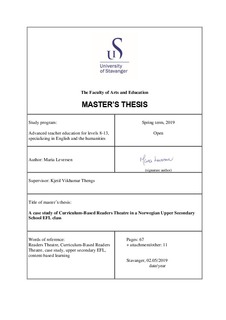| dc.description.abstract | This thesis is based on a case study of using Curriculum-Based Readers Theatre (CBRT), a group reading activity where pupils rehearse and perform content-based texts, in an upper secondary school English as a foreign language (EFL) class. The class consisted of 28 pupils and their teacher. The research questions aimed at finding how CBRT functions as a reading strategy for learning content in English class, as well as looking at the benefits and challenges of the project. The project also aimed at connecting CBRT to content-based learning and instruction.
Two variants of CBRT was used: firstly, the pupils were given a pre-written CBRT script which they practiced. Secondly, the groups were given one topic each, and created and performed their scripts for the class. One class session was spent to introduce the pupils and teacher to CBRT, four class sessions were spent working on the scripts and performing.
Different methods were used for collecting data, making for a mixed method research. The teacher and a group of pupils were interviewed twice: pre- and post project. In addition, the class was also given a pre- and post project questionnaire. The researcher functioned as a participating observer. Using interviews made it possible to get an in-debt view of the teacher's and the pupils' thoughts and opinions towards the project. The questionnaire made it possible to get to know the whole class' thoughts on the project, and to compare the results found in both methods.
The study revealed that CBRT is a fun and motivating method where the pupils learn content in a new and creative way. They were enthusiastic when working with and performing their scripts. The activity gave the class the opportunity to become closer socially, as they needed to cooperate in groups and step out of their comfort zone when performing. CBRT covers several curricular aims from the national subject curriculum LK06, which makes it a valid method to use in upper secondary school. The project revealed that CBRT is a successful method to implement in upper secondary school. The pupils learned to become more confident speaking English in class, how to cooperate in groups, and how to create their own CBRT scripts.
The most challenging parts of the project were logistics and time. It is a time consuming activity, and it requires structured planning. The researcher solved this by planning the project in good time ahead, and the pupils were given different topics so that as much content as possible were covered. It was evident that the benefits outnumbered the challenges.
Most of the research on RT or CBRT in Norway has been conducted in primary and lower secondary schools, and the researcher has only found one study that has previously been done on CBRT in lower secondary school in a Norwegian EFL context. The present study, with its focus on upper secondary school, has contributed to expand on the research on RT and CBRT. The results of this project have found that CBRT has great potential in upper secondary school; however, it should be followed up by for example more case studies, in order to confirm the findings in this thesis. | nb_NO |

